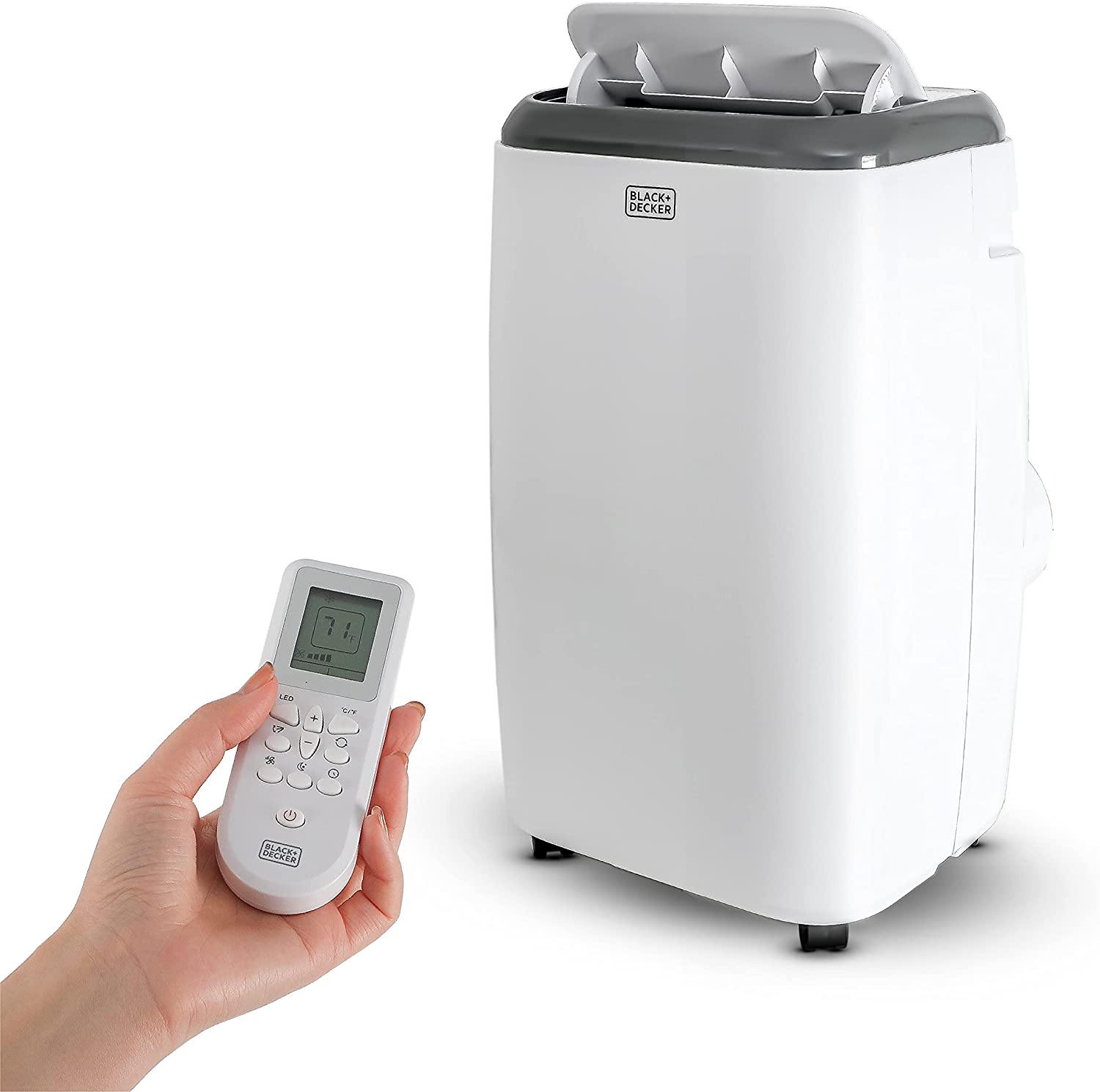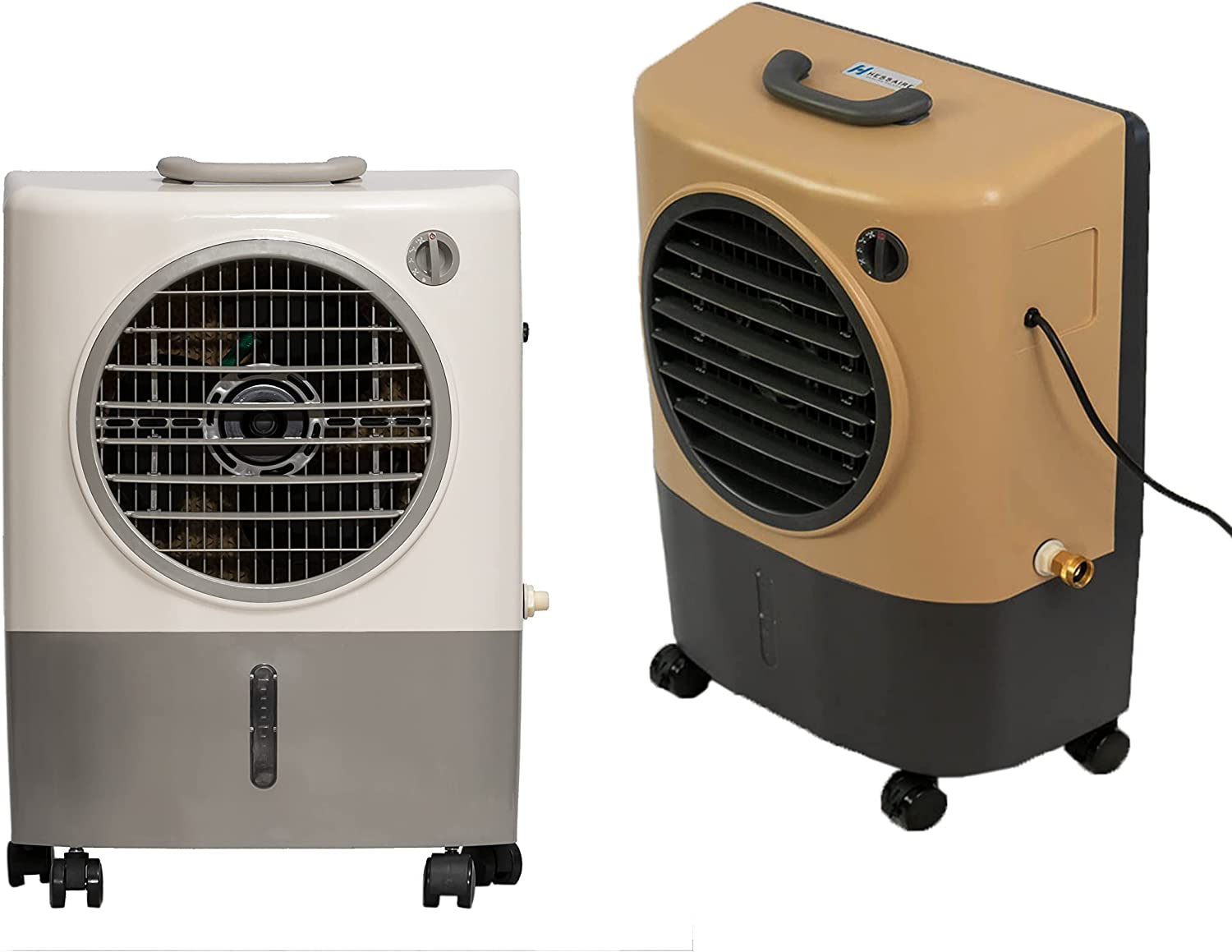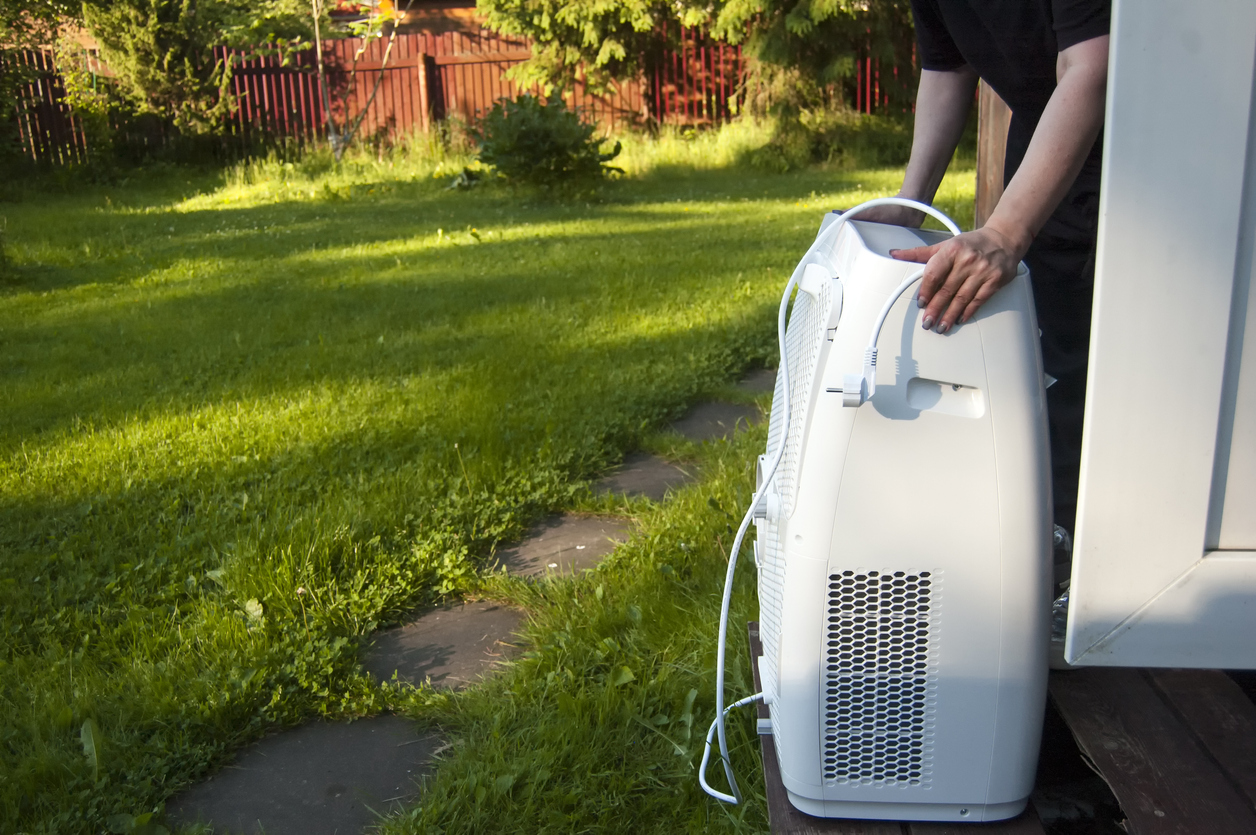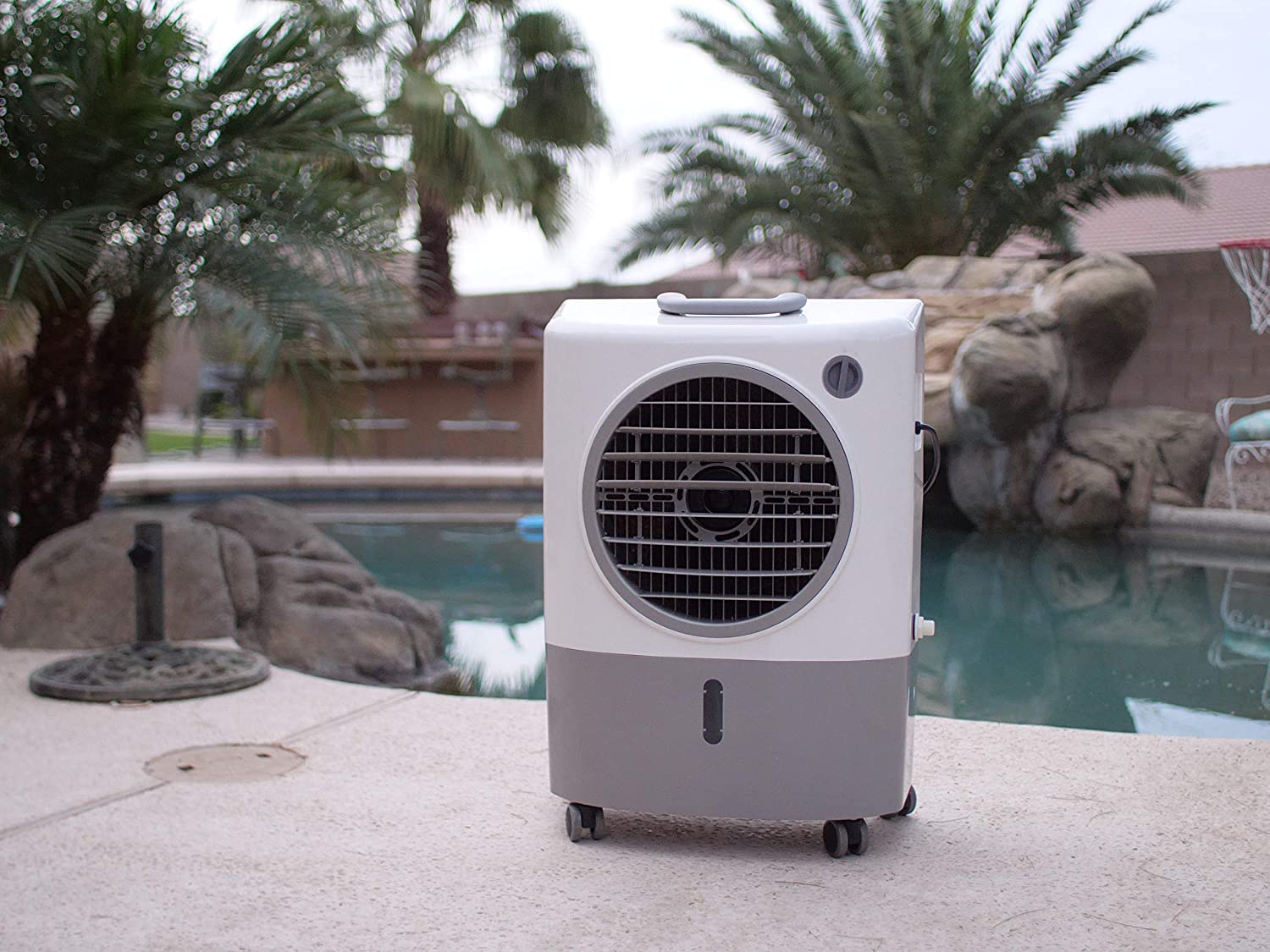We may earn revenue from the products available on this page and participate in affiliate programs. Learn More ›
During hot summer months, staying cool and keeping your home comfortable is a top priority. However, choosing the best device that ensures we can relax and escape the heat is not always so easy. Both portable air conditioners and evaporative coolers are marketed as an effective solution to cool a living space, but which one is right for you?
There are actually a number of key evaporative cooler vs. air conditioner differences to consider. Understanding these differences can help you decide which cooling device will best meet your needs.
RELATED: 15 Clever Hacks to Help You Beat the Summer Heat
Air conditioners use a chemical refrigerant to cool and dehumidify indoor air.

Air conditioners cool homes by removing the hot air and adding cooler air. An AC unit—whether it be a central unit, portable unit, or window unit—consists of a loop of different coils or tubes, which continues from inside to outside of the home. A chemical refrigerant circulates through this loop. Heat inside the home is absorbed by the refrigerant and sent outside. As this occurs, the AC unit also releases cool dry air to further lower the temperature inside while also decreasing humidity.
An air conditioner is a closed system. In order for the unit to function efficiently, a home’s windows and doors need to be closed. Open windows or doors will let cooled air out and more hot air in, forcing the air conditioner to work longer to maintain a lower interior temperature.
Our Recommendation: Black+Decker 14,000 BTU Portable Air Conditioner on Amazon for $429
This sleek, quiet, and wheeled portable air conditioner can quickly cool rooms as large as 450 square feet down to its lowest temperature setting of 61 degrees Fahrenheit.
Evaporative coolers utilize water to humidify and cool rooms.

Evaporative coolers also cool the air, but they use a different process than air conditioner units. Also called a swamp cooler, an evaporative cooler uses water and a fan to lower the temperature in a room. Think about how your body feels when you step out of the shower. As the water on your skin evaporates, it makes you feel cooler. This same principle can help explain how a portable evaporative cooler works.
Inside of an evaporative cooler, pads are soaked with water. Then, the fan pulls the warm air from outside over the damp evaporative cooler pads. As the water evaporates off of the pads, it lowers the temperature of the air. The fan in the cooler then pushes this cool air out into the rest of the room.
The effectiveness of an evaporative cooler can vary based on the starting outdoor temperature. The higher the temperature, the more significant the temperature drop will be. For example, if the exterior temperature is around 90 degrees Fahrenheit, a good evaporative cooler should be able to decrease the interior air temperature by 20 to 30 degrees.
Our Recommendation: Hessaire MC18M Portable Evaporative Cooler on Amazon for $189
This compact evaporative cooler features a 4.8-gallon water tank that can effectively cool and humidify a room or outdoor space for 3 to 4 hours. Its garden hose adapter and float valve also allow for continuous use without worry of overflowing or drying out the water tank.
Swamp coolers bring fresh outside air into a home and improve indoor air quality, but closed-system air conditioners are better for allergy sufferers.

Evaporative coolers are open systems. That means that some doors or windows must be at least partially open when they are in use to provide a way for the warm air to escape. Cooling with the doors and windows open increases the amount of fresh air in the home and can improve the home’s air quality.
While more fresh air is often viewed as a benefit of swamp coolers, it is not always ideal for people with allergies. Individuals sensitive to pollen and other indoor allergens may fare better with a portable air conditioner that operates with the windows closed.
Moreover, if you live in an area where air pollution or wildfire smoke are common concerns, an air conditioner unit may be the better choice as well. In these types of climates, it’s safest to leave the windows and doors closed, and evaporative coolers can potentially pull air pollutants like smoke into your home.
Air conditioners are suitable for any climate while evaporative coolers lose effectiveness in humid conditions.
One of the most important portable air conditioner vs. evaporative cooler differences relates to the climates they’re best suited to. While an air conditioner unit will work well in any climate, dry or humid, the same is not true for evaporative coolers.
As mentioned above, evaporative coolers lower the temperature in a room by passing the warm air over damp cooling pads. As the water evaporates, it decreases the indoor temperature. However, the evaporating water also increases indoor humidity. In dry climates, such as those in the Southwest, more humidity can be a good thing.
However, in climates that already have higher levels of humidity, such as along the East Coast, adding more humidity into the air will not make the people inside feel any more comfortable. Increasing the humidity in these areas could also lead to the growth of mold or mildew.
RELATED: The Best Portable Air Conditioners for Keeping Cool, Tested and Reviewed
Evaporative coolers are less expensive to purchase, install, and operate than air conditioners.

The upfront cost to purchase an evaporative cooler is typically significantly less than the cost to purchase a refrigerative air cooler. The savings on a non-portable unit are even greater, with the average cost of installing a central air conditioner being between $3,810 and $7,480—much higher than even the high-end evaporative cooler installation estimate of $3,500.
Another important swamp cooler vs. air conditioner difference lies in the operating costs of the two units. Evaporative coolers are much more energy-efficient than air conditioners, using as much as 80 percent less electricity.
However, keep in mind that the lifespan of an evaporative cooler is typically less than that of an air conditioner, particularly a whole-home unit. Most evaporative cooler manufacturers typically only provide a 5-year warranty for their units. Compare this to the 10-year average lifespan of a portable air conditioner and 12- to 17-year average lifespan of a central air conditioner.
Typically, air conditioners produce greater CO2 emissions and noise compared to swamp coolers.
An evaporative cooler can be a more environmentally friendly choice than an air conditioner cooler. With the design of evaporative coolers relying solely on water and electricity, these units’ carbon emissions are kept relatively low.
Even though the refrigerants used in today’s air conditioners are much safer than those used years ago, they are still toxic chemicals. Refrigerant leaks pose health and environmental risks, and an AC’s greater electrical needs result in much higher CO2 emissions than evaporative coolers. For this reason, individuals looking to reduce their carbon footprint may decide that an evaporative cooler is the best fit for their preferences.
As a plus, swamp coolers also tend to be quieter when operating compared to air conditioners.
Swamp coolers require more frequent upkeep than air conditioners.
While swamp coolers may have lower installation and operating costs, one important evaporative air cooler vs. air conditioner difference relates to the maintenance each unit requires. Even a small evaporative cooler will need regular maintenance. As water runs through the unit, it can deposit minerals and sediment that could interfere with its proper function. An evaporative cooler needs to be cleaned at least once each cooling season—possibly more frequently, depending on usage and air temperature. Also, its various parts need to be examined throughout the cooling season, including the pump, filter, and reservoir.
To prevent an evaporative cooler’s water tank from getting too dirty and allowing bacteria to grow, it needs to be emptied and sanitized at least twice a week. Evaporative cooler pads should be replaced at least twice each season, or monthly in areas where the unit is in constant use. The pads themselves should also be cleaned at least once monthly.
While air conditioners should also be properly maintained, they don’t require as much attention as an evaporative cooler. Typically, scheduling a yearly HVAC checkup with a pro is sufficient, along with some basic maintenance and upkeep that’s required for a portable air conditioner. An AC unit’s water collection tray should be drained regularly.
A portable air conditioner’s filters should also be checked frequently—generally about twice a month—to keep them clean and free of blockage. The coils, exterior vents, panels, and other dust-collecting crevices on a portable AC should also be regularly cleaned.
Portable air conditioning units are meant for indoor use only, whereas portable evaporative coolers can be used outdoors.

You won’t hear about an outdoor air conditioner. That’s because air conditioners can only be used indoors with the windows and doors closed.
A major evaporative cooling unit vs. air conditioner difference is that you can actually use an evaporative cooler outside. The effect of setting up an evaporative cooler outside will feel similar to sitting by a lake with the cooler air from the water blowing on you. An evaporative cooler may not drop the outside air temperature quite as much as it can indoors, but it could still help cool down nearby air by more than 10 degrees.
RELATED: 10 Tricks for Keeping Cool Without Air Conditioning


